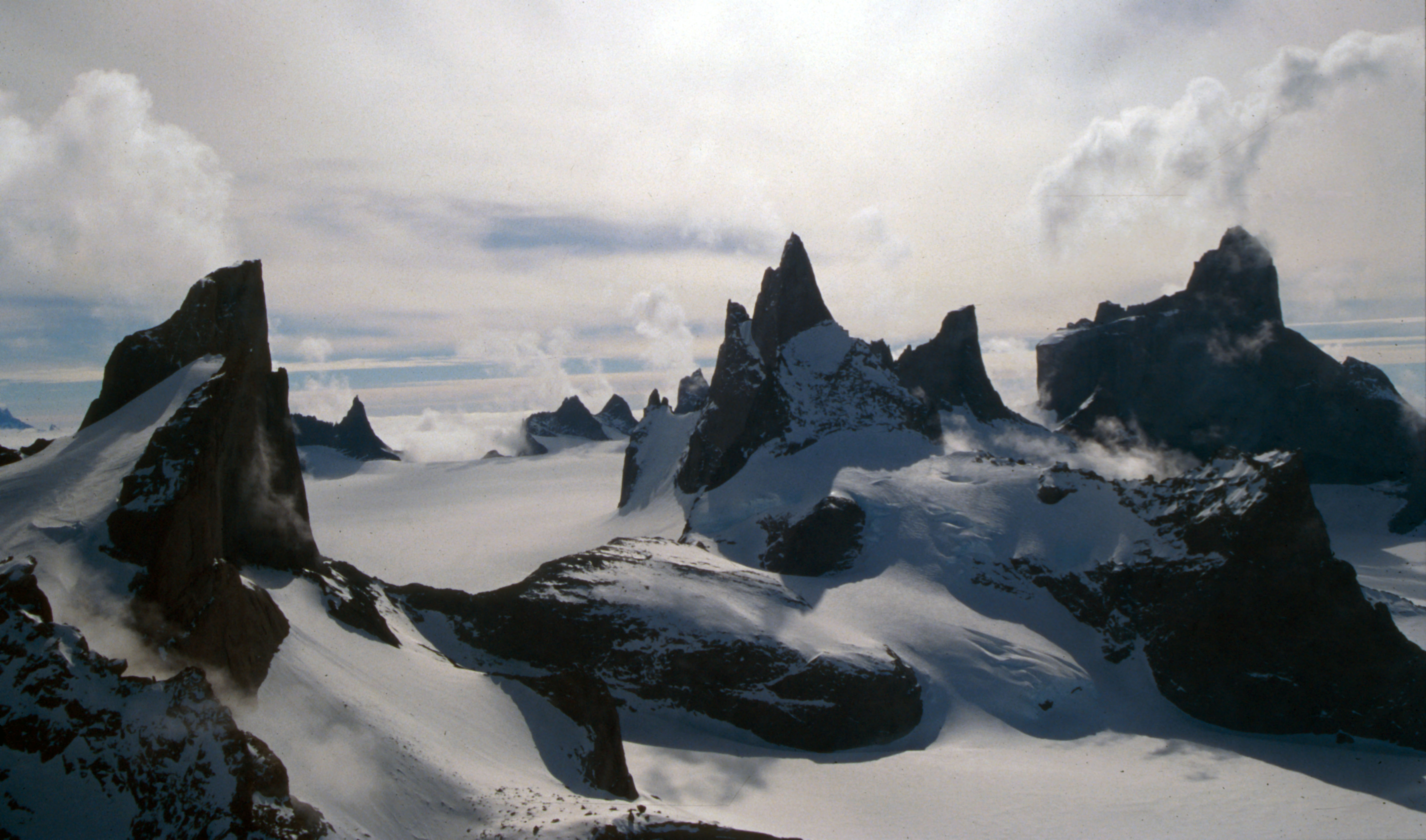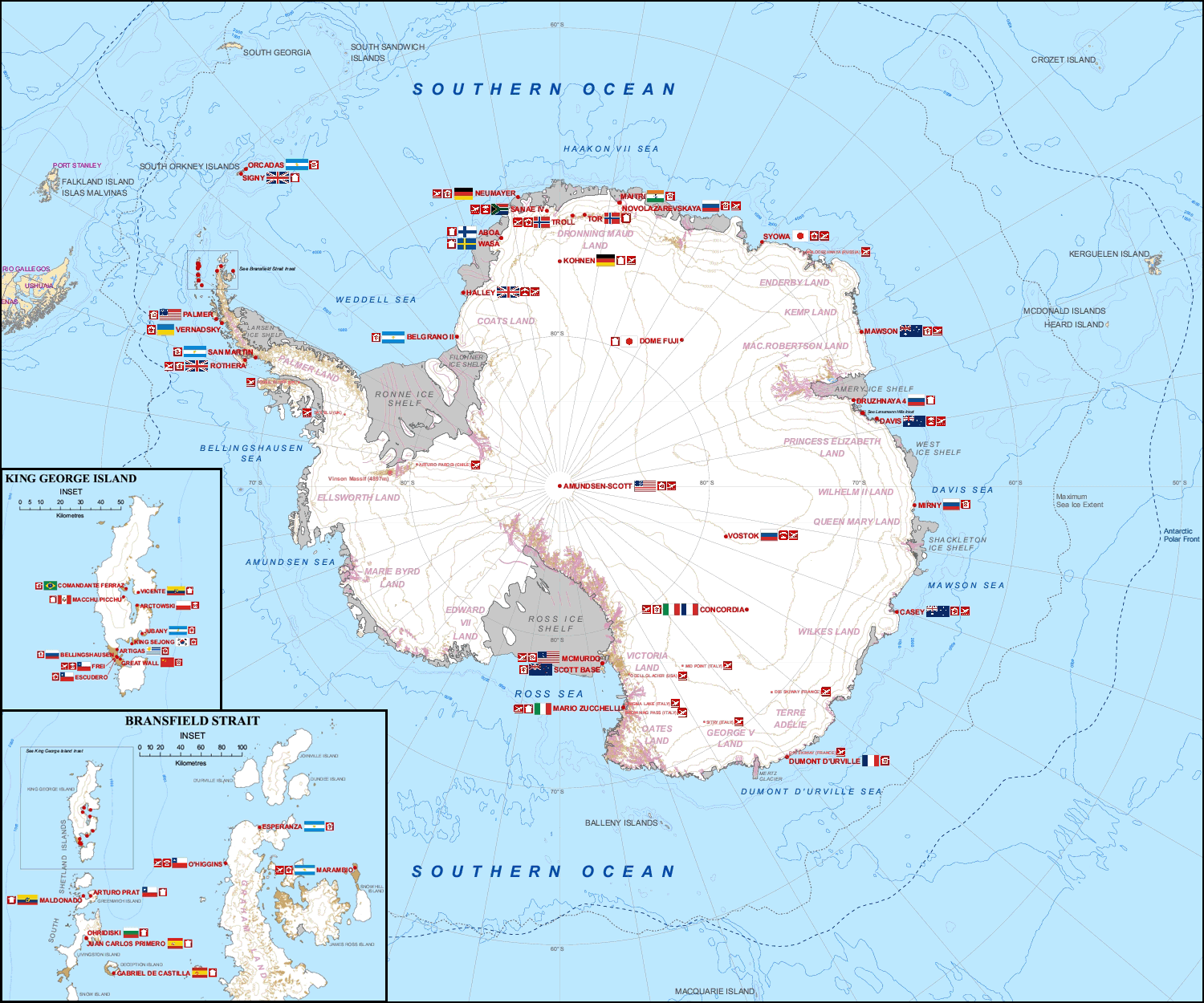|
Novolazarevskaya
Novolazarevskaya Station (russian: Станция Новолазаревская) is a Russian, formerly Soviet Union, Soviet, Antarctic research station. The station is located at Schirmacher Oasis, Queen Maud Land, from the Antarctic coast, from which it is separated by Lazarev Ice Shelf. It was opened on January 18, 1961 by the 6th Soviet Antarctic Expedition. The maximum summer population is 70. Novolazarevskaya has an airstrip (ICAO:AT17) that serves both research-related and commercial flights. In 2010 GLONASS differential reference station started to work in Novolazarevskaya. The reference station also provides Internet to Novolazarevskaya personnel. Novolazarevskaya is east of India's Maitri (research station), Maitri research station. Climate Novo Runway It is a blue ice runway, located away, operated by Antarctic Logistics Centre International (ALCI) serves the station and Maitri (research station), Maitri. See also * Research stations in Antarctica#List of r ... [...More Info...] [...Related Items...] OR: [Wikipedia] [Google] [Baidu] |
Schirmacher Oasis
The Schirmacher Oasis (or Schirmacher Lake Plateau) is a long and up to wide ice-free plateau with more than 100 freshwater lakes. It is situated in the Schirmacher Hills on the Princess Astrid Coast in Queen Maud Land in East Antarctica and is, on average, above sea level. With an area of , the Schirmacher Oasis ranks among the smallest Antarctic oases and is a typical polar desert. Geography The oasis is located between the edge of the Antarctic Ice Sheet and the ''Novolazarevskaya Nivl Ice Shelf''. The approximately high plateau of the Schirmacher Oasis is a barrier to the northwards-running ice stream. On the northern edge of the oasis are so-called epishelf lakes, bays separated from the ocean which are connected with the ocean underneath the surface of the ice. Thus, tidal effects can be observed in the lakes. The epishelf lakes can contain either mere freshwater or saltwater which is overlaid by freshwater. The Antarctic Ice Sheet, southwards of the Schirmacher Oasis ... [...More Info...] [...Related Items...] OR: [Wikipedia] [Google] [Baidu] |
Queen Maud Land
Queen Maud Land ( no, Dronning Maud Land) is a roughly region of Antarctica claimed by Norway as a dependent territory. It borders the claimed British Antarctic Territory 20° west and the Australian Antarctic Territory 45° east. In addition, a small unclaimed area from 1939 was annexed in June 2015. Positioned in East Antarctica, it makes out about one-fifth of the continent, and is named after the Norwegian queen Maud of Wales (1869–1938). In 1930, the Norwegian Hjalmar Riiser-Larsen was the first person known to have set foot in the territory. On 14 January 1939, the territory was claimed by Norway. On 23 June 1961, Queen Maud Land became part of the Antarctic Treaty System, making it a demilitarised zone. It is one of two Antarctic claims made by Norway, the other being Peter I Island. They are administered by the Polar Affairs Department of the Norwegian Ministry of Justice and Public Security in Oslo. Most of the territory is covered by the east Antarctic ic ... [...More Info...] [...Related Items...] OR: [Wikipedia] [Google] [Baidu] |
Dronning Maud Land
Queen Maud Land ( no, Dronning Maud Land) is a roughly region of Antarctica claimed by Norway as a dependent territory. It borders the claimed British Antarctic Territory 20° west and the Australian Antarctic Territory 45° east. In addition, a small unclaimed area from 1939 was annexed in June 2015. Positioned in East Antarctica, it makes out about one-fifth of the continent, and is named after the Norwegian queen Maud of Wales (1869–1938). In 1930, the Norwegian Hjalmar Riiser-Larsen was the first person known to have set foot in the territory. On 14 January 1939, the territory was claimed by Norway. On 23 June 1961, Queen Maud Land became part of the Antarctic Treaty System, making it a demilitarised zone. It is one of two Antarctic claims made by Norway, the other being Peter I Island. They are administered by the Polar Affairs Department of the Norwegian Ministry of Justice and Public Security in Oslo. Most of the territory is covered by the east Antarctic ic ... [...More Info...] [...Related Items...] OR: [Wikipedia] [Google] [Baidu] |
Research Stations In Antarctica
Multiple governments have set up permanent research stations in Antarctica and these bases are widely distributed. Unlike the drifting ice stations set up in the Arctic, the research stations of the Antarctic are constructed either on rock or on ice that is (for practical purposes) fixed in place. Many of the stations are demographics of Antarctica, staffed throughout the year. A total of 42 countries (as of October 2006), all signatories to the Antarctic Treaty System, Antarctic Treaty, operate seasonal (summer) and year-round research stations on the continent. The population of people performing and supporting scientific research on the continent and nearby islands varies from approximately 4,000 during the summer season to 1,000 during winter (June). In addition to these permanent stations, approximately Antarctic field camps, 30 field camps are established each summer to support specific projects. History First bases During the Heroic Age of Antarctic Exploration in t ... [...More Info...] [...Related Items...] OR: [Wikipedia] [Google] [Baidu] |
Maitri (research Station)
Maitri also known as Friendship Research Centre, is India's second permanent research station in Antarctica as part of the Indian Antarctic Programme. The name was suggested by then-Prime Minister Indira Gandhi. Work on the station was first started by the Indian Expedition which landed there in the end December 1984, with a team led by Dr. B. B. Bhattacharya. Squadron Leader D. P. Joshi, the surgeon of the team, was the first camp commander of the tentage at camp Maitri. The first huts were started by the IV Antarctica Expedition and completed in 1989, shortly before the first station Dakshin Gangotri was buried in ice and abandoned in 1990–91. Maitri is situated in the rocky mountainous region called Schirmacher Oasis. It is only away from the Russian Novolazarevskaya Station. Facilities The station has modern facilities to research in various disciplines, such as biology, earth sciences, glaciology, atmospheric sciences, meteorology, cold region engineering, ... [...More Info...] [...Related Items...] OR: [Wikipedia] [Google] [Baidu] |
Leonid Rogozov
Leonid Ivanovich Rogozov (russian: Леони́д Ива́нович Ро́гозов; 14 March 1934 – 21 September 2000) was a Soviet general practitioner who took part in the sixth Soviet Antarctic Expedition, 1960–1961. In April 1961 he had developed appendicitis while at Novolazarevskaya Station, and being the only medical professional there at the time, had to perform his own appendectomy. Early years Leonid Rogozov was born in Borzinsky District Dauriya Station, Chita Oblast, a remote village in eastern Siberia, a little over 10 miles from the Soviet border with Mongolia and China, near Manzhouli. His father was killed in World War II in 1943. In 1953, Rogozov completed his studies at a secondary school in Minusinsk, Krasnoyarsk Krai, and was admitted to the Saint Petersburg State Pediatric Medical Academy Leningrad Pediatric Medical Institute now Saint Petersburg. After graduating in 1959 as a general practitioner, he started clinical training to specialise in sur ... [...More Info...] [...Related Items...] OR: [Wikipedia] [Google] [Baidu] |
Soviet Antarctic Expedition
The Soviet Antarctic Expedition (SAE or SovAE) (russian: Советская антарктическая экспедиция, САЭ, ''Sovetskaya antarkticheskaya ekspeditsiya'') was part of the Arctic and Antarctic Research Institute of the Soviet Committee on Antarctic Research of the Academy of Sciences of the USSR. The Soviet Union's Ministry of Sea Transport was responsible for the administration, logistics and supply of the expeditions. The first Soviet contact with Antarctica was in January 1947 when the Slava whaling flotilla began whaling in Antarctic waters. Stations The first Soviet Antarctic station, '' Mirny'', was established near the coast on February 13, 1956. This was added to in December 1957 by another station, ''Vostok'' built inland near the south geomagnetic pole. Year-round stations * Mirny (established February 13, 1956) * Vostok (established December 16, 1957) * Novolazarevskaya (established January 18, 1961) * Molodyozhnaya (established January 1 ... [...More Info...] [...Related Items...] OR: [Wikipedia] [Google] [Baidu] |
List Of Airports In Antarctica
__TOC__ List , 18/36Ice , - valign=top , Palmer SkiwayHeliport , , NZ12 , , Anvers Island , , 01/19Snow , - valign=top , Patriot Hills Blue-Ice Runway , , SCPZ , , Ellsworth Mountains , , 24MIce , - valign=top , Pegasus Field(serving McMurdo Station and Scott Base) , , NZPG , , Ross Island , , 15/33Ice08/26Ice (skiway) , - valign=top , Perseus RunwayTemporary Airfield , , , , , , 10/28Blue Ice , - valign=top , Petrel Skiway , , SA47 , , Dundee Island , , 08/26Ice , - valign=top , Phoenix Airfield(serving McMurdo Station and Scott Base) , , NZFX , , Ross Island , , 15/33Compacted Snow , - valign=top , Plateau Station Skiway , , AT20 , , Queen Maud Land , , 18/36Ice , - valign=top , Plog Island Skiway(serving Davis) , , , , Plog Island , , (variable)Ice , - valign=top , Princess Elisabeth Skiway , , QAP , AT99 , Utsteinen Nunatak , , Blue Ice , - valign=top , Progress Skiway , , , ... [...More Info...] [...Related Items...] OR: [Wikipedia] [Google] [Baidu] |
Antarctic Field Camps
Many Antarctic research stations support satellite field camps which are, in general, seasonal camps. The type of field camp can vary – some are permanent structures used during the annual Antarctic summer, whereas others are little more than tents used to support short term activities. Field camps are used for many things, from logistics (Sky Blu) to dedicated scientific research (WAIS Divide Field Camp). List of field camps See also *Research stations in Antarctica *Demographics of Antarctica *List of Antarctic expeditions This list of Antarctic expeditions is a chronological list of expeditions involving Antarctica. Although the existence of a southern continent had been hypothesized as early as the writings of Ptolemy in the 1st century AD, the South Pole was no ... * Transport in Antarctica References External links COMNAP Antarctic Facilities() COMNAP Antarctic Facilities Map() Antarctic Digital Database Map ViewerSCAR {{Polar exploration Field ... [...More Info...] [...Related Items...] OR: [Wikipedia] [Google] [Baidu] |
GLONASS
GLONASS (russian: ГЛОНАСС, label=none, ; rus, links=no, Глобальная навигационная спутниковая система, r=Global'naya Navigatsionnaya Sputnikovaya Sistema, t=Global Navigation Satellite System) is a Russian satellite navigation system operating as part of a radionavigation-satellite service. It provides an alternative to Global Positioning System (GPS) and is the second navigational system in operation with global coverage and of comparable precision. Satellite navigation devices supporting both GPS and GLONASS have more satellites available, meaning positions can be fixed more quickly and accurately, especially in built-up areas where buildings may obscure the view to some satellites. GLONASS supplementation of GPS systems also improves positioning in high latitudes (north or south). Development of GLONASS began in the Soviet Union in 1976. Beginning on 12 October 1982, numerous rocket launches added satellites to the system, unti ... [...More Info...] [...Related Items...] OR: [Wikipedia] [Google] [Baidu] |
Blue Ice Runway
A blue ice runway is a runway constructed in Antarctic areas with no net annual snow accumulation. The density of the ice increases as air bubbles are forced out, strengthening the resultant ice surface so that aircraft landings using wheels instead of skis can be supported. Such runways simplify the transfer of materials to research stations, since wheeled aircraft can carry much heavier loads than ski-equipped aircraft. Blue ice runways are created as a way of streamlining transport to the interior. Without them, most heavy materials must be brought by ship, then ferried inland by ski-equipped smaller aircraft. Large, wheeled aircraft can fly directly into the interior, saving time and money. In particular, they allow for rare medical evacuations to take place year round. The United States Antarctic Program uses them to support its substantial science activities. Because of ice's low coefficient of friction, planes tend to decelerate with reverse thrust, as opposed to tradit ... [...More Info...] [...Related Items...] OR: [Wikipedia] [Google] [Baidu] |
ICAO
The International Civil Aviation Organization (ICAO, ) is a specialized agency of the United Nations that coordinates the principles and techniques of international air navigation, and fosters the planning and development of international air transport to ensure safe and orderly growth. ICAO headquarters are located in the '' Quartier International'' of Montreal, Quebec, Canada. The ICAO Council adopts standards and recommended practices concerning air navigation, its infrastructure, flight inspection, prevention of unlawful interference, and facilitation of border-crossing procedures for international civil aviation. ICAO defines the protocols for air accident investigation that are followed by transport safety authorities in countries signatory to the Chicago Convention on International Civil Aviation. The Air Navigation Commission (ANC) is the technical body within ICAO. The commission is composed of 19 commissioners, nominated by the ICAO's contracting states and appo ... [...More Info...] [...Related Items...] OR: [Wikipedia] [Google] [Baidu] |


%2C_Norwegian_aviator%2C_explorer_and_businessman_(small).jpg)




